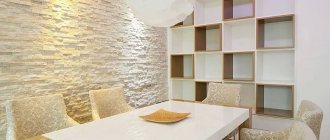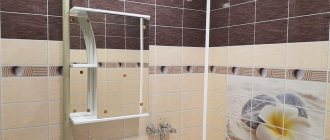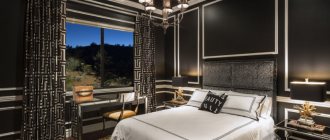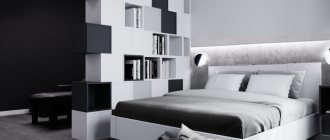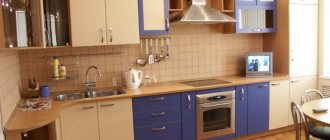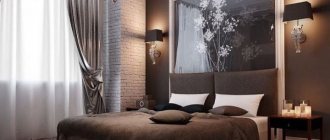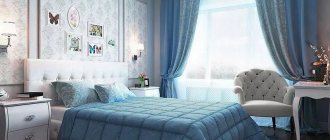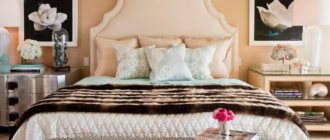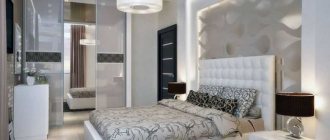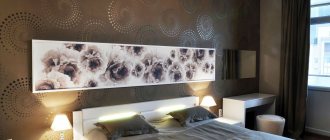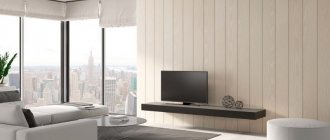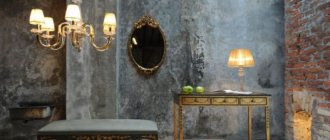Choosing a laminate for wall decoration
When choosing wall laminate for the bedroom, you should pay special attention to its appearance, wear resistance class and fastening system.
A wall decorated with laminate should look attractive, be in harmony with other types of decoration and fit perfectly into the overall design of the room. To a large extent it depends on the appearance of the finishing material.
It is better to choose a laminate with embossing and patterns that will match the style of the floor, wallpaper or plaster on the walls, and wooden furniture elements.
The choice of shade depends on the design idea. The color of laminate on the wall can be combined with flooring, furniture, wallpaper and textiles. Or it can contrast with the general background of the interior if used to decorate an accent wall at the head of the bed.
The degree of wear resistance of the laminate may not be too high. After all, there is practically no load on this material on the walls.
The type of fastening system depends on the quality of the surfaces being finished. For smooth walls, adhesive laminate is perfect.
For problematic walls, it is better to use material with tongue and groove or click locks.
When finishing uneven walls with laminate, you will have to carry out some preparatory work.
First, let's decide how we will attach the laminate to the wall.
Decoration and decoration of walls
You can make wall decorations yourself or have a professional do it for you. It's your choice, we just have some ideas on how to do it.
Black and white
The classics of the genre are white decorative plaster or matte wallpaper and black laminate. This combination is always winning. The floor can be lined with long-pile fabric, and the headboard can be upholstered in leather. There are many possible combinations, but if you want to choose white laminate flooring for your bedroom, then black or dark brown will suit you.
An interesting option is to lay long sections of laminate vertically, so that there is a gap between them. The material should preferably be light, but the walls should be darker. If you place the spotlight correctly, the effect will be amazing.
Black will highlight, creating an even flow of light on black fabric, while white will give a cool and balanced effect.
A highlight in the light
Lighting can be varied. There are several popular options:
Installing classic lighting away from the wall where the laminate is laid. This is especially important when using non-solid materials. In the case of a solid pastel color, wall sconces installed in pairs are suitable.
A wall light can resemble a lamp or a candle. Another option is spotlights placed horizontally at the edge of the ceiling.
If the laminate is laid on a recess, then the spotlight is placed vertically on both sides of the recess. Such lighting will attract attention and optically enlarge the bedroom, creating a feeling of spaciousness and comfort.
One wall
What types of bedroom designs are suitable for laying single-color laminate flooring on an entire wall:
- predominance of one color;
- Maximum three colors;
- Avoid installing large chandeliers close to the wall;
- The main wall design should contrast with the shade of the laminate (dark-light or light-light);
- the ceiling and wall selected can be the same as the floor and wall;
- The smallest wall or the wall adjacent to the head of the bed is usually finished with laminate.
If you decide to highlight only one part of the room, it is best to start from the top. Ceiling plinths are not used.
Decorative vinyl laminate
Vinyl (PVC) is an excellent decorative material that can be laid on the surface of absolutely any room. It is moisture resistant and self-adhesive.
Panel
To add variety to the design, you can make a wall panel from laminate. You can play with colors. The panels can be laid lengthwise or crosswise.
Behind the sofa
The wall behind the sofa can be accented with laminate. It is ideal for accentuating a room and making it the main point of interest.
Options for attaching laminate to the wall
There are several ways to attach laminate to the wall, the choice of which depends on the size and shape of the bedroom.
Horizontal mounting is best used in small rooms with low ceilings. The laminate should be laid in a checkerboard or cascade pattern so that the joints of the boards are less noticeable.
In low rooms it is worth using such finishing in the form of panels that do not reach the junction of the wall and ceiling. By fixing the laminate to the wall in this way, you can visually expand the space and raise the ceiling.
The vertical installation method is also good for low bedrooms. But in narrow rooms it is better not to use it, since vertical stripes will stretch the room even more. This type of installation is perfect for covering the entire surface of the wall.
Diagonal mounting of laminate on the wall can be used in bedrooms of any size. Surfaces finished in this way look original and stylish. This is the best solution for decorating an accent wall.
This type of laminate installation is the most labor-intensive, requiring perfect fit of the cuts. It should also be taken into account that the consumption of finishing material in this case will be greater than with horizontal and vertical installation.
Types of laminate
Laminates vary in abrasion resistance class and pattern, as well as in the type and texture of the surface of the top layer on the panels. It is important to choose the right option for each floor. There is no universal solution for all interiors and premises.
By surface type
Laminate planks, depending on the number of “boards” in the lamellas, are divided into:
- one lane;
- two stripes
- with three stripes;
- multi-band;
- tile (stone).
There is no direct relationship between the number of stripes and the width of the plate. It all depends on the idea of the designer of a particular collection.
Laminate floor structure
Wide single-lane strips work best in large open spaces. Laying a laminate with such a structure more than 20 centimeters wide in a room of 10-15 square meters is not recommended. It will not look good on such a floor, especially if it is filled with furniture.
Planks with three or more stripes resemble narrow parquet boards of different shades. They are ideal for small rooms and corridors. Their two-way counterparts are a versatile choice for medium-sized living rooms, bedrooms and kitchens.
By design and surface structure
The texture of the surface layer of the laminate can be different:
- Classic - matte wood feel and lacquered finish;
- Corrugated - imitation of wood texture with a relief surface;
- Glossy, semi-gloss and matte (with wax coating);
- With or without chamfer.
If you want something natural and authentic, grooved laminate is the way to go. The texture of the wood on it is not only visible in all its glory, but also felt by bare feet and hands.
The choice between glossy and matte surfaces is more a matter of personal preference for the homeowner. Some people love gloss and shine in their interiors, while others definitely don't like it.
The beveled edge gives the laminate planks the appearance of massive parquet planks. This makes the floor look more chic and interesting than a simple beveled version.
If you are laying laminate on a base that is not perfectly level, it is better to choose a laminate with a chamfer along the entire perimeter of the board. This way, unevenness will be less noticeable.
By wear resistance class
Depending on the strength and degree of abrasion resistance, laminated boards are divided into several quality classes, which can be identified by markings.
Numbers 21-23 indicate that these products are intended for use in low traffic residential areas.
Classes 31-33 indicate the high level of abrasion resistance offered by laminate floors for use in public buildings and high-density apartments. This is the most durable floor covering and is usually purchased as a topcoat.
In the case of wall cladding, it makes sense to save money, since the load on such finishing is much lower. As a result, class 21-23 is best suited, and if such a product is not available, you can choose boards with a protection degree of 31.
Boards of domestic or European production are considered the most reliable. However, it is better not to buy Chinese ones, as they contain a high content of harmful substances. Good quality lining from the USA, but too expensive.
How to attach laminate flooring to a wall
Correct installation of laminate on the wall begins with calculating its quantity. To do this, you need to calculate the area of the wall surface to be finished by multiplying its height by its width. 10% is added to the result obtained for adjustment and loss of material during cutting.
Next, you need to select the starting point for installation. If the entire wall is covered, then installation of the first row begins from the ceiling at a distance equal to the width of one laminate board. Moreover, this does not affect how to fix the laminate on the wall: horizontally, vertically or diagonally. The rule is the same for all types of installation.
If only the lower part of the wall is being finished, fastening begins from the floor. To ensure an even placement of the stripes, you can make markings on the wall.
Then you can proceed directly to laying the laminate. When gluing the material, silicone adhesive or liquid nails are applied to the strip, which is then pressed firmly against the wall. To better fix the boards to each other, their locks can also be coated with glue.
When installed on a wooden or metal sheathing, a gap is created between the laminate and the wall, which can be filled with soundproofing material. This will eliminate the formation of echoes when covering large areas. It can also be used to lay various communications.
The strips are fastened to the frame using nails or clamps.
Fastening with clamps
Clamps are special staples made of galvanized material. They come with jagged or flat ridges. The end boards of the laminate are secured with serrated clamps. And the second type is used to secure strips near click locks.
The use of these fasteners makes it easy to lay each next row with tight fixation of the locks.
The clamps are secured to a wooden or metal frame with ordinary nails, self-tapping screws or a construction stapler. When installing on lathing, the last row of laminate is laid on liquid nails.
The final stage of installation work is the installation of decorative skirting boards and corners. They are usually glued to liquid nails.
We highlight in the living room
The living room, decorated with laminate, can look just as interesting as the bedroom.
There are no clear rules on how to do it right
It plays not only a decorative, but also a practical role. In addition to an impressive design that creates coziness, laminate allows you to hide, for example, wires from a TV behind the skin.
For your information! Ease of maintenance is also important - stains, fingerprints and other contaminants are easily removed from the surface.
We enliven the interior with bright decor
Warm shades of wood add relaxation to the room, while cool shades create an unusual, intriguing impression.
With such a design of the fireplace, the atmosphere is given masculine severity and even asceticism. In large rooms, you can cover a column, one of the walls, or just a corner in this way.
Laminate flooring must be laid on a perfectly flat surface.
If such a wall seems empty in the living room, you can revive and balance it for a harmonious interior using the following techniques:
- decorative shelves to match on which to place souvenirs or books;
- arrange decorative beautiful sconces;
- hang paintings or photographs in stylish frames.
We revive it with decorative shelves to match
For your information! The selection can only affect the recreation area or a fragment of the wall with a TV.
How to lay laminate flooring on a flat wall
The easiest and fastest way to lay laminate on a flat wall surface is with adhesive. In this case, you can use both laminate without a locking system, and its type with click and tongue and groove locks.
Expert opinion
Nikolay Smirnov
Electrician by training. He has extensive experience in a variety of fields, including renovation work, furniture manufacturing, plumbing work, etc. Currently, he provides services mainly to private customers (small house and garden work, installation of doors and furniture, plumbing and electrical repairs, etc. .).
Before laying the laminate on the wall, its surface must be cleaned and treated with a primer. This will improve the quality of fastening and eliminate the possibility of the boards falling away from the wall.
It is better to use liquid nails to attach the trim. Strips without locks are smeared with glue, laid tightly next to each other in a checkerboard pattern and pressed tightly against the wall.
When installing interlocking laminate, you need to very carefully connect them to each other, making sure to hold the previous row.
If you are finishing a small area, you can assemble the entire structure on the floor, and then apply glue and attach it to the wall surface.
Tips for choosing panel shades
Since the panels can be of completely different shades, you need to be very careful when choosing a color.
Decorating walls with laminate will look harmonious in settings of many stylistic trends.
Please note that laminate can combine one, two or three basic tones.
If you want to make a bedroom in a classic style, and the interior will be rich in other decorative elements, then you should give preference to more neutral panel surfaces.
The popularity of this finishing material is also due to its affordable cost.
If the interior is minimalistic, then you can, on the contrary, opt for products with a wide variety of textures and color combinations. In this case, such a wall will become an accent in the room.
To decorate walls, it is not at all necessary to spend money on sheets of a high strength class, as, for example, to decorate a floor.
The following features must be taken into account.
- If the level of illumination in the room is low, then finishing the walls with laminate should be done exclusively locally and with a choice of light shades, as indicated in the photo of the bedroom design.
- If the room is spacious and well-lit enough, then you can make a dark panel element on the wall.
Today in building and finishing materials stores you can find a wide range of different laminate options.
Color combination
Sometimes it is allowed to combine two or more shades of laminate. This looks especially good in rooms that are equipped in industrial and modern interiors and high-tech style. In this case, several panels of matching colors are combined in a checkerboard pattern or with an arbitrary offset.
Laminate does not emit harmful substances that have an adverse effect on the human body.
When combining colors, you can combine white, gray and different shades of brown. This can be complemented by splashes of black panels.
It must be taken into account that laminate does not like temperature changes.
How to fix laminate flooring on an uneven wall
The wall surface is not always perfectly flat. The optimal solution to this problem would be to install a special frame made of wooden or metal slats.
To create a wooden sheathing you will need slats 20-40 mm wide. They are attached to the wall surface using self-tapping screws at a distance of 30 cm and are located perpendicular to the laminate strips.
The metal sheathing is made from slats used for installing drywall. The installation method and arrangement of the strips are the same as for a wooden frame.
Advantages and disadvantages
Laminate is a relatively inexpensive and accessible material that will cost much less than real wood panels. At the same time, it is in no way inferior in quality to them if you choose the right wear resistance class. Even outwardly, it is quite difficult to distinguish a high-quality laminate from the wood under which it is made.
Decor
The collections of major manufacturers delight with a variety of shades and textures. In addition to the classic wood-look laminate, there are entire series of stone, masonry, monolithic colored coatings and other interesting solutions.
Wear resistance and insulation
Wear-resistant laminate is a practical coating that does not require complex maintenance, unlike natural boards. It can be wiped with a regular cloth and polished with special products.
Finishing walls with laminate improves the heat and sound insulation characteristics of the room. And if necessary, there are special moisture-resistant, fire-resistant and impact-resistant collections.
Application
You can even handle laminate installation yourself thanks to convenient locks. Of course, when laying a coating on a wall, there are some nuances regarding laying laminate on the floor. But even this can be dealt with if you approach the issue carefully and carefully.
Laminate is a lightweight material, compared to heavy types of wood, ceramic tiles or natural stone. Due to this, it does not overload the base and can even be used to cover decorative plasterboard structures.
Flaws
When laying laminate, the wall must be perfectly flat and without drops, otherwise you will need lathing. The material is sensitive to humidity and temperature changes, so only specialized series are suitable for kitchens and bathrooms. Such cladding requires space and takes up valuable centimeters, which is why it is not the best option for small rooms.
Possible problems when installing laminate on the wall
Laminate is a fairly heavy material, so the surface of the wall and the structure on which it is attached must be very durable.
Fastening nails, staples and self-tapping screws must not get into the locking systems. Otherwise, the lock will not click completely, which will lead to the formation of gaps between the boards.
What to do if the wall is uneven
To install laminate flooring on uneven walls, they can be prepared in several ways.
The most common method is leveling surfaces using plaster. The laminate is fixed using liquid nails or silicone glue.
You can cover the walls with sheets of plywood. But this method is not suitable for finishing small areas, since the plywood structure will protrude forward, and this can ruin the appearance of the entire wall.
Expert opinion
Nikolay Smirnov
Electrician by training. He has extensive experience in a variety of fields, including renovation work, furniture manufacturing, plumbing work, etc. Currently, he provides services mainly to private customers (small house and garden work, installation of doors and furniture, plumbing and electrical repairs, etc. .).
The best way to install laminate flooring on uneven walls is to lay it on a special sheathing. This type of fastening guarantees reliable fixation of the finish and, due to the small thickness of the structure, will not disturb the aesthetics of the interior.
Necessary tools and preparatory work
Depending on which fastening method was chosen, you should prepare:
- laminate panels;
- glue or special composition;
- a hacksaw for wood (for metal for working with clamps);
- self-tapping screws;
- primer impregnations;
- staples.
Such a layout is often found not only in fashionable studio apartments, but also in classic homes with interior partitions.
Once the installation method has been chosen and all the necessary tools and materials have been prepared, you should begin preparing the wall surface. They must be brought to a plane, otherwise the laminate will bend. The voids underneath can also cause the panels to break if you lean on them.
It is worth noting the wear resistance of such a popular material.
When the wall is leveled, it must be carefully primed - this manipulation ensures reliable adhesion between the glue and the wall.
The laminate itself is very durable.
If the wall is damp and damp, for example, it is located at the end of a building that constantly gets wet, then you can additionally walk over it with an antifungal compound.
Bedroom interior with laminate
In bedrooms, laminate is most often used as an accent wall above the head of the bed. Designers recommend choosing this finish in the same color scheme as the furniture.
Beautiful lamps will look great on such a wall, the light from which will favorably emphasize the texture and pattern of the material.
You can use paintings and decorative panels as decoration on the bedroom wall.
Often laminate on the wall in the interior is used to zone space. You can highlight each of the zones using different installation methods, colors and types of embossing.
The variety of textures and patterns allows you to use laminate to decorate rooms in any style. Surfaces with this finish can imitate various natural materials: stone and brickwork, marble, wood of various species and even leather.
Therefore, a wall decorated with laminate will look great in a bedroom interior in Provence, Art Deco, Country, Minimalism and High-Tech styles.
White laminate with a beautiful texture is ideal for decorating walls in a classic bedroom interior. Its combination with furniture and other decorative elements will give the bedroom a sophisticated and original look.
For a classic bedroom, it is better to use laminate with a glossy surface, which will look more luxurious and elegant.
Using laminate as a decorative finish for walls in the bedroom allows you to add individuality and sophistication to the interior. Plus, this low-maintenance material will look great for many years to come.
Color combinations
Before you start finishing work, think about future moves and the color palette of the room. Neutral tones pair best with wood trim. However, even bright colors can go well with laminated walls.
Yellow
Another combination that exudes warmth and naturalness. Here you can go two ways - create contrast, for example, using an industrial concrete ceiling, or create a warm and natural interior. In the first case, a lemon-yellow shade and a laminate with a gray-beige texture are suitable.
For the second - mustard, honey for accent walls and curtains and chocolate-colored wood. Both have the right to exist in modern styles.
Red color
Fiery red color is quite active, attracts attention and creates an accent. Therefore, choose a floor of very calm shades.
In the kitchen, this could be a laminate flooring that imitates natural wood, a warm brown color that echoes the table, chairs and floor of a similar shade. Add a casual accent with pendant lamps above the table and an original poster.
In the bedroom, red should be used sparingly. Use white as a base and then add some red and gray elements such as laminate flooring and pillows.
Green color
The texture of wood with greenery is ideal for eco-style. Choose a laminate with a pattern that is as close as possible to natural wood, this is the only way you can achieve the desired effect. Let the light in - hang light curtains or beige blinds on the window and fill the room with the charm of enchanting white.
When it comes to decor, everything is very simple. Animal images on posters, pillows, photographs, along with a large bouquet of wildflowers or indoor plants can create the feeling that you are in a wooden house surrounded by a beautiful forest or meadow.
White color
Shades of white combined with wood create a perfect, light and airy duet. The interior looks very natural and clean.
Depending on your wishes, select the temperature of the color combination. This can be a warm color scheme - use milky colors in combination with light wood. This design will fit perfectly into a Scandinavian-style room.
Or you can go the other way - rely on unavailable white and wood colors with a gray undertone. If you want to decorate your bedroom this way, be sure to add soft, textured fabrics to make the room feel cozier.
Briefly about the main thing
- A wall finished with laminate gives the interior a feeling of closeness to nature. Ideal for eco-style bedrooms, chalets, scandi, etc.
- Laminate flooring on the wall can be mounted vertically, horizontally and diagonally. The vertical method is good for narrow bedrooms with low ceilings, the horizontal method is good for small rooms, and the diagonal method is good for any room.
- It is advisable to choose a laminate color close to the shade of the furniture.
- Laminate flooring is calculated based on the area of the wall where it is planned to be attached. To do this, you need to multiply the length by the width. An additional 10% is added for fitting, trimming, etc.
- There are several ways to attach laminate to the wall: adhesive, with clamps, with lathing. The choice of a specific option depends on the initial quality of the coating.
What is the advantage of finishing?
- The slats are durable - the surface can be hit and there will be no marks.
- The finishing material does not absorb moisture - its structure is quite dense, without pores. In addition, during production, the boards are covered with an additional layer of protection.
- Care is not anything special - a regular detergent is enough. But do not overdo it with water - it is better not to leave the surface too wet and soapy.
- Despite the fact that the finishing material is made from non-natural resources, this does not affect environmental friendliness. The material is safe for health and does not evaporate harmful substances.
- And it’s also convenient to install - you can even do it yourself.
Photo: Instagram alina_lyutaya
Photo: Instagram alina_lyutaya
Photo: Instagram alina_lyutaya
Photo: Instagram natalya011211
How to beat the decoration in the hallway?
The corridor is a space without natural light. And for this reason, it is wrong to lay dark-colored material there. Choose light colors to add light and coziness.
And you don’t have to cover the entire wall completely. Sometimes decorating one niche or section of the wall is enough - for example, to zone a room or allocate space for shoes.
Photo: Instagram metrix_design
Photo: Instagram metrix_design
- Hallway
Design of a small hallway in Khrushchev: secrets of proper design
Why do you need a headboard?
The headboard of the bed is, first of all, one of the important parts of the product frame, which ensures reliability and safety. Its second important function is to create comfort for its user.
After all, a bed without a headboard is not as comfortable as with one: you can lean on the back and recline, read your favorite book before going to bed or watch TV. Third purpose: the headboard can be an excellent bedroom decor.
Features that are worth considering when choosing a headboard:- Wide and massive headboards take up quite a lot of space and make the room heavier, so they should not be considered for small rooms.
- Quite often, a double bed with a headboard also provides additional storage space. After all, many modern headboards are equipped with spacious shelves and various compartments. By choosing this option, you can completely abandon bedside tables.
- A bed with a high headboard can radically change the interior of a room and emphasize the unsurpassed taste of the bedroom owner.
- Before purchasing, be sure to take into account the style of the room so that both the material and design fit the overall interior - modern furniture manufacturers offer a wide variety of materials, the choice is yours.
- If you like to read, work on the computer or watch TV before going to bed, then you should pay attention to a bed with a soft headboard.
- If you want a unique and inimitable design, then you can make the headboard of the bed with your own hands - in fact, it is not very difficult.
Design ideas in different styles
To design the bedroom walls, you need a laminate that will harmonize perfectly with different finishing styles. This includes strict and elegant classics, slightly sloppy country, as well as Provence.
The demand for this material is explained by its low cost, because for finishing walls you don’t have to purchase panels of the highest level of strength, which are used for the floor.
Nowadays, building materials stores sell a wide range of laminated boards. Varieties of material differ in styles and colors.
This material does not release toxic or harmful substances to human health. In fact, laminate can be used to create durable and harmless bedroom floors for adults and children.
Is installation possible in the bathroom?
A question that causes a lot of controversy. After all, laminate is an artificial tree. And it is no less afraid of large amounts of moisture than natural ones - which is typical for toilets and bathrooms.
However, the use of this material in the bathroom is still possible. If several conditions are met. The first is good ventilation. Today there are modern sensors that turn on the fan when the humidity level reaches a set point. And the second condition is accuracy. You still can’t pour water on the laminate, so in the bathtub or shower area it’s better to choose wood-look porcelain tiles.
Photo: Instagram iceramic.moldova
Photo: Instagram iceramic.moldova
